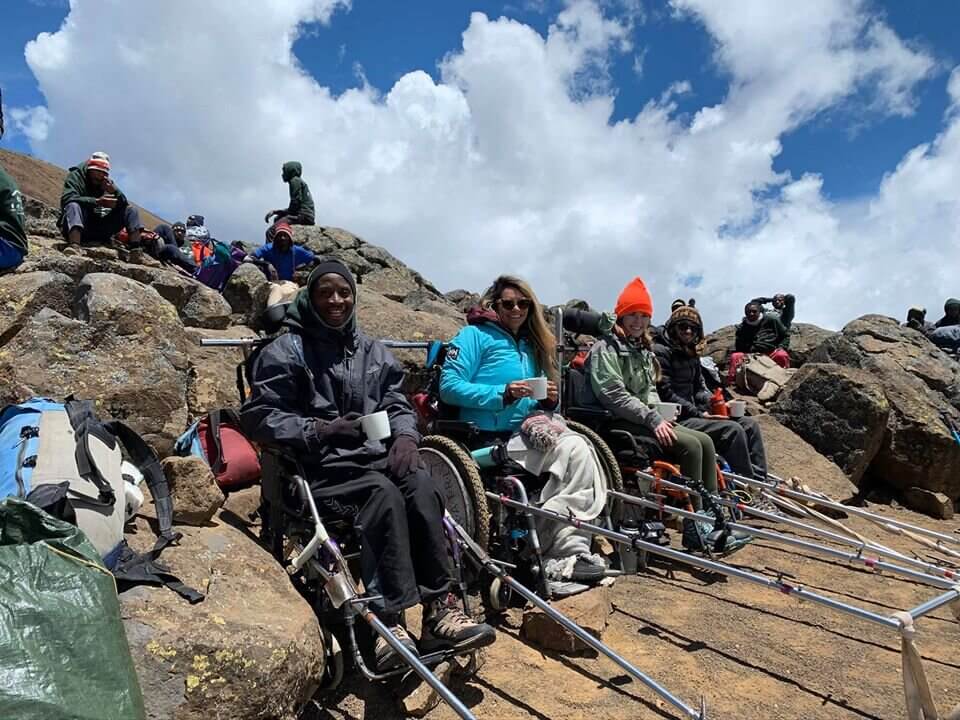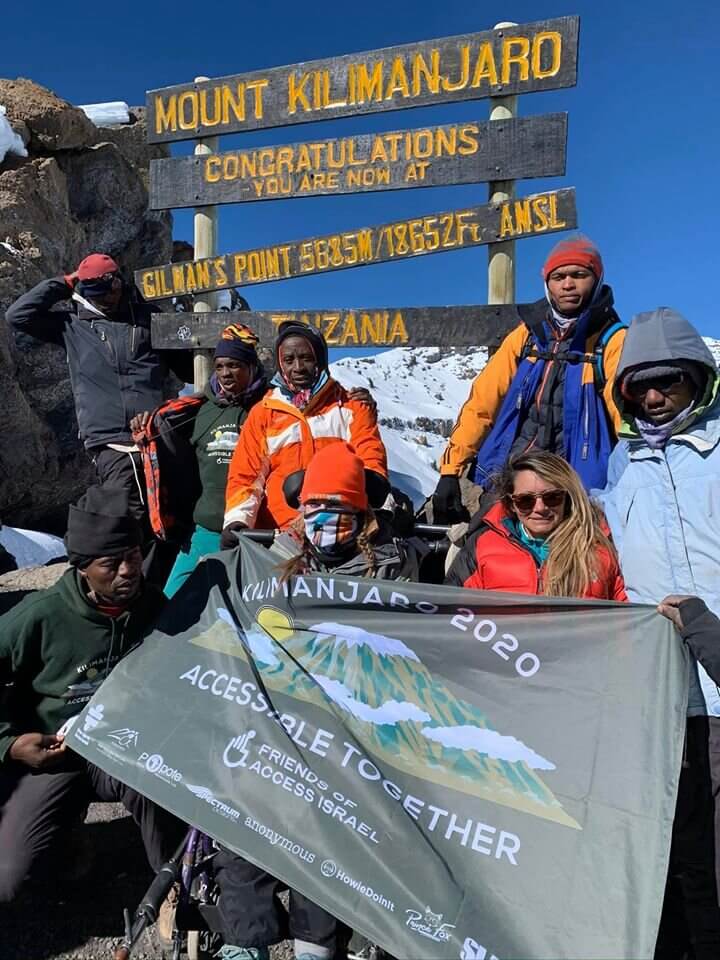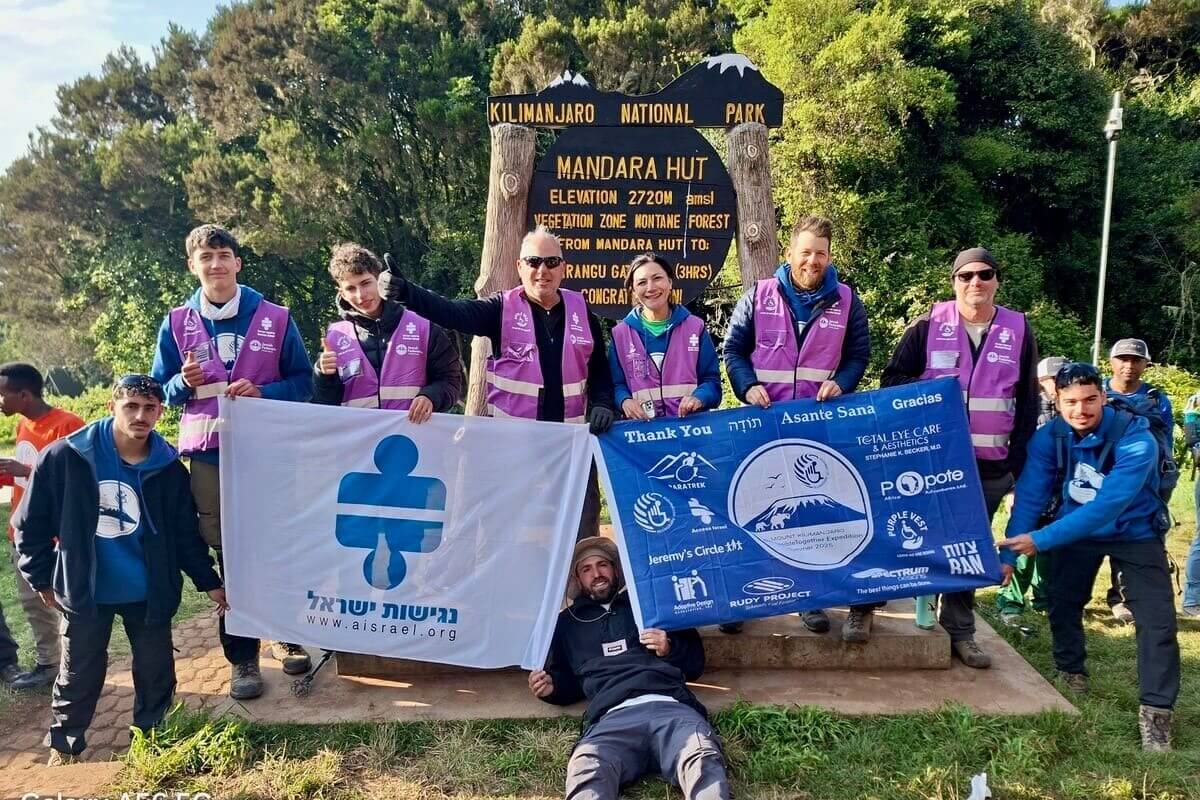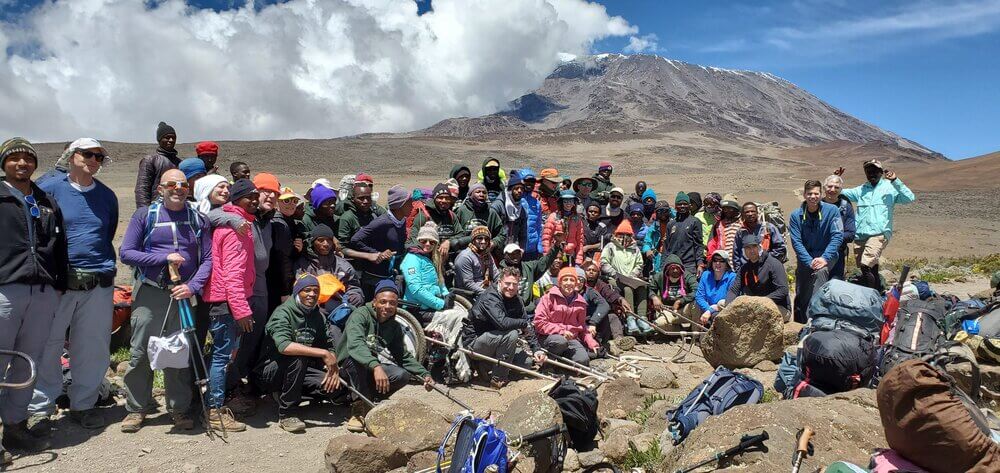A group of hikers, some in purple vests, poses with flags in front of a wooden sign for Mandara Hut in Kilimanjaro National Park. One person is lying on the ground in front, holding a flag.
The Climb of a Lifetime
Original Article Published on The Flyer Blog
My colleague and friend Jamie Lassner, executive director of Friends of Access Israel (FAISR), recently heard a number of people using the phrase, “I feel paralysed” as they cope with trying times posed by COVID-19. Lassner’s lifelong friend, Alan T. Brown, who has been a wheelchair user since he became paralysed as a teenager 33 years ago – and who has an incredible sense of humor – remarked, “Welcome to my life!
In fairness, what can people without paraplegia or quadriplegia possibly know about day-to-day life for a person who is paralysed? After nearly two weeks of climbing Mount Kilimanjaro, the famed 19,341-foot mountain in Tanzania – an experience that included not showering or using flush toilets, and hiking through the night in the cold and snow to reach the summit on the final ascent – 23 hikers came to know their four fellow climbers living with paralysis very well.
This past February, about a month before Covid-19 changed the lives of so many, a delegation of 27 climbers with different abilities from across the United States, Israel and Tanzania participated in the strenuous, multi-day, heavily-supported climb to benefit Friends of Access Israel (FAISR). FAISR is an organisation that promotes accessibility, inclusion and respect for people of all abilities around the world. FAISR’s collaborative partner, Access Israel, was founded just over 20 years ago in Israel.
Climbing Kilimanjaro is no walk in the park. It is a bucket list item for many people. Friends wondered how my fellow hikers and I were training – especially since many of us live in New York City, with little access to high elevations for training. They wondered, though they may have been shy to ask, how people who cannot walk could possibly climb Africa’s highest mountain.

To start, never tell a woman who travels the world alone, dressed in her signature “The Journey of a Brave Woman” jean jacket, that something is impossible. Marcella Marañon, a Peruvian-born woman with paraplegia and who has an amputated foot, is simultaneously gentle and tough. She regularly shares experiences with accessibility, from Peru to India to Israel, on her very active social media sites.
Starla Hilliard-Barnes, a twice-paralysed participant (yes, you read that right!), also refuses to be defined by her disabilities. She was selected as Ms. Wheelchair Montana in 2014 and became the first wheelchair user to compete in the Mrs. Montana pageant in 2016. She is also the founder of Moving Forward Adaptive Sports (an organisation that enables differently abled individuals to engage in adaptive recreational activities) and the charity, Gifts of Love (which brings holiday presents to individuals with disabilities, veterans, individuals in hospital and families in need). Starla was accompanied by her husband, Shannon Barnes, on the expedition. “The last day I was in pain but just tried to smile. I just tried to stay positive. That was me, happy and smiling the whole time.”
“[Friends] wondered, though they may have been shy to ask, how people who cannot walk could possibly climb Africa’s highest mountain.”
Arnon Amit was paralysed in a car accident during his Israel Defense Forces (IDF) army service. Arnon flew to Tanzania with fellow Israeli, Omer Zur, founder of Paratrek – the company that created the durable ‘Trekker’ chair used by the paralysed participants and their extensive support teams to ascend the mountain. Arnon’s next challenge is riding on horseback with two friends from Israel’s southernmost to northernmost points. The journey was scheduled for April but will be rescheduled due to Covid-19.
Arnold John had spent his life watching others in his Tanzanian village ascend and even serve as porters on Kilimanjaro expeditions. This gentle 44-year-old paralysed father of three finally received the opportunity to climb the famed mountain himself with the FAISR delegation.
The group of climbers were supported throughout the journey by three cooks, 11 guides and 70 porters. Porters carry all participant clothing and sleeping bags, as well as food, water and cooking supplies. Cooks provided kosher meals both at the huts and along the route. Daily mileage ranged from 3.1 miles on the acclimation days to 13.7 miles during the final midnight-to-sunrise ascent to the summit.

Paratrek’s founder, Zur, summed up what I suspect the entire group felt during this experience: “ascending the peak of Kilimanjaro is a dream come true, not because of the mountain … The dream that we fulfilled is to see this group – people with and without disabilities, and major ones – climbing up together as a group; as people who see each other as equals.”
Everyone returned home as friends and equals, with countless memories, dozens of photos and videos, strong bonds and an appreciation that we all have abilities beyond our disabilities. None of the trip participants speak of feeling paralysed; they speak very fondly of their new friends who happen to be paralysed.
Thank you Marcela, Starla, Arnon and Arnold for being such great teachers!
The big push to the top of Kilimanjaro
Original Article Published in The Paa Tanzania page 30-31
Climbing Mt. Kilimanjaro is a tough task for anyone, but for four
paraplegic climbers it was the ultimate challenge. This year, thanks
to the latest in durable climbing chairs and a team of Tanzanian
and international alpinists, the quartet’s lifelong dreams to reach
the ‘roof of Africa’ were realised. Here writer Howard Blas, who was
part of the expedition, reveals the collective effort involved.
Arnold John always dreamed of climbing Mount Kilimanjaro. The 44-year-old Tanzanian father of three grew up at the base of the dormant volcano and has family members who have worked as porters, yet he never had
the opportunity to attempt the strenuous, multi-day trek to the top. As a teenager, the talented student and soccer player was struck with an acute illness that left him paralysed and dependent on crutches and a wheelchair to get around. Despite his condition, John’s dream of reaching the summit never left him and this February he saw it come true – thanks to the support of Friends of Access Israel (FAISR), an organisation promoting
accessibility and inclusion, and 27 fellow climbers – including three others with paraplegia.
The Kilimanjaro climb was the brainchild of the executive director of FAISR,
James Lassner, and drew the support of the organisation’s collaborative partner, Access Israel.
Lassner was delighted when the climb’s architect and co-ordinator Sabino ‘Sabi’ Kweka – a former porter and guide, who is now owner of the popular Moshi tour operator Popote Africa Adventures – suggested John be included in the expedition. Kweka had drawn up the expedition to follow the Marangu route, also known as the Coca Cola trail, and to involve overnight stays in the Mandara Hut (2,700 metres), Horombo Hut (3,700 metres), and
the Kibo Hut (4,700 metres) on the way up.
The group would then attempt the final all-night ascent to the 5,895-metre Uhuru Peak Lassner said: “Every day people with disabilities face many personal mountains to climb, some visible but most hidden.
They are no different than anyone else as they have the same dreams, desires, hopes, and aspirations including ‘bucket list’ items.”
The FAISR Kilimanjaro 2020 Team included hikers from the Caribbean island of Aruba and Israel as well as Texas, Montana, Pennsylvania, New
York, and New Jersey in the United States.
Other hikers with physical disabilities who participated in the climb included Starla Hilliard-Barnes of Utah, a twice-paralysed participant; Marcela Maranon, an amputee who is also a paraplegic; and Arnon Amit,
paralysed in a car accident during his time in the Israel Defense Forces.
State-of-the-art chair

It was a big operation. Climbers were accompanied by three cooks, 11 guides and 70 porters. The latter carried all participants’ clothing and sleeping bags as well as their food, water and cooking supplies. Cooks provided kosher meals both at the huts and along the route.
Regular food breaks were crucial: daily mileage ranged from 3.1 miles on the acclimation days, to 13.7 miles during the final midnight to sunrise ascent to the summit. The climb was made possible for the participants with paraplegia thanks to the Patatrek Trekker, a durable chair designed by Israeli participant Omer Zur, who is the chief executive of the Israeli Paratrek company. He designed the special chair to enable his paralysed father to enjoy outdoor adventures with friends with and without disabilities.
Each trekker was pulled, pushed and guided by a dedicated team of six porters. Participants without disabilities divided into teams – Team Marcela, Team Starla, Team Arnon and Team Arnold – and hiked together through five climatic zones and often rough terrain.
Triumph of teamwork
Peruvian-born and Dallas, Texas-based Maranon, 38, who has 48,000 Instagram followers keeping up with her solo globetrotting adventures, found the climb a challenging, but ultimately rewarding experience. “For me it was very hard,” she says. “It was so steep. Thirty minutes before we got to the summit, you could just look down and see all the way down.
It was so scary.”
Hilliard-Barnes, who made the trip with her husband, Shannon Barnes, kept a positive attitude throughout the trip, including on the last day when she fell ill.
“The last day I was in pain but just tried to smile” she says. “I just tried to stay positive. That was me, happy and smiling the whole
time.” She offered comfort and encouragement to fellow climbers throughout the trip – even as they experienced difficulties on the climb.
Zur saw the climb as a triumph of teamwork. He says: “Ascending the peak
of Kilimanjaro is a dream come true not because of the mountain. That was never a dream of mine. The dream that we fulfilled is to see this group – people with and without disabilities – climbing together, as a group, as people who see each other as equals. To see that, out there in a super
non-accessible trail, that for me is a reason to continue doing what we do!”
Thankfully, every participant reached one of Mt Kilimanjaro’s three summits— Stella’s Point (5,756 metres), Gilman’s Point (5,685 metres) or Uhuru Peak (5,995 metres).
Lassner is very proud of everyone involved. He says: “Our successful summiting of Mt Kilimanjaro was fueled by the diverse abilities and deep inner strengths of each individual that they contributed to enhance the experience of team.”


